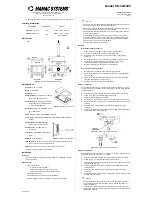
ENC-900 Operating Manual: Chapter 4 Configuration
25
PHP=1
PHP=2
PHP=1
SHP=2
Master
Repeater
Slave
Network 50
Hop Pattern 1
Hop Pattern 2
Figure 7 -
Repeater
Operation
Master
Repeater
Slave
Repeater
Slave
PHP=1
PHP=1
SHP=2
PHP=2
PHP=2
SHP=3
PHP=3
Hop-
Pattern 1
Hop Pattern 2
Hop Pattern 3
Figure 8 -
A Network
Utilizing Three Hopping
Patterns
If there is no DTE connected
to the Repeater, turn off
handshaking (&K0) and set
the baud rate to 115K.
3) Remote.
Up to 255 Remotes may exist in a network, all of which
communicate with the common Master (either directly or via Repeater(s)).
Remotes cannot directly communicate with other. Remotes only provide
acknowledgement for packets of data sent by the Master when the Master is
in Point-to-Point mode. In multipoint mode, multiple Remotes would
conflict with one another if they were all trying to acknowledge the Master
at the same time. The Master does, however, send acknowledgements to all
messages it receives from Remotes. The Master initiates communications
by sending a broadcast message to all Remotes. Each Remote can choose
one of several windows in which to transmit. If there happens to be two
Remotes attempting to talk at the same time, the Master may not receive the
data, and the Remotes therefore would not get an acknowledgement. At
this point, the Remotes would attempt to get the information through at
random time intervals, thus attempting to avoid any more conflicts. Special
parameters which control the Remote’s response characteristics can be
modified with S Registers S115 and S213.
4) Repeater.
A more precise title would be Repeater/Remote, because
a Repeater also has much of the same functionality as a Remote. A terminal
can be connected at the Repeater location and communicate with the Master
terminal. There is no restriction to the number of Repeaters in a network,
allowing for communication over virtually limitless distances. The
presence of one Repeater in a network automatically degrades system
throughput by half. Additional Repeaters, regardless of the quantity, do not
diminish system throughput any further. To understand Repeater operation,
consider the module as belonging to two hopping patterns at the same time:
The Primary Hopping Pattern and the Secondary Hopping Pattern. In
Figure 7, the Master belongs to Hopping Pattern 1, and communicates with
the Repeater on this hopping pattern. The Remote belongs to Hopping
Pattern 2, and communicates with the Repeater on this hopping pattern.
The whole system belongs to Network 50 (i.e., all units must be assigned
the same Network Address (S104), which in this case was selected to be 50.
Note that Remotes and Master only communicate on their respective
Primary Hopping Pattern. Repeaters communicate on the Primary Hopping
Pattern when communicating with the Master (or with another Repeater
between itself and the Master). Repeaters communicate on their Secondary
Hopping Pattern when communicating with Remotes (or with another
Repeater between itself and the Remotes). Figure 8 shows another
example.
If the Repeater is not also being used as a Remote (there is no DTE
connected to the serial port), it is recommended that the Repeater’s baud
rate be set to 115K, and that handshaking be disabled (&K0). This will help
ensure a smooth flow of data through the network.
Summary of Contents for ENC-900
Page 9: ...ENC 900 Operating Manual Chapter 2 Electrical Physical 5 ...
Page 17: ...ENC 900 Operating Manual Chapter 2 Electrical Physical 13 ...
Page 44: ...40 ENC 900 Operating Manual Chapter 4 Configuration ...
Page 46: ...42 ENC 900 Operating Manual Appendix A Modem Command Summary ...
Page 48: ...44 ENC 900 Operating Manual Appendix B Factory Default Settings ...
Page 50: ...46 ENC 900 Operating Manual Appendix C Technical Specifications ...
Page 54: ...50 ENC 900 Operating Manual Appendix E Approved Antennas ...
















































